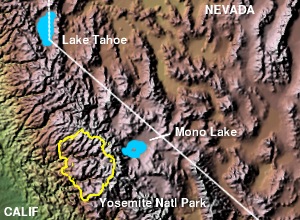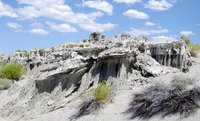Mono Lake
|
|
Mono Lake is an alkaline and hypersaline lake in California, United States that is a critical nesting habitat for several bird species and is one of the most productive ecosystems in North America.
Mono Craters to the right of the image are rhyolitic domes. The dark colored Negit Island is of volcanic origin and is somewhat less than 2000 years old. Pahoa Island is the larger and lighter colored island in the lake and was formed 300 years ago from uplift caused by magma movement. Black Point is the remnant of a cinder cone volcano that erupted under water in prehistoric times, when Mono Lake was much larger (and referred to as Lake Russell).
In order to provide water for growing Los Angeles, water was diverted from the Owens River and then from the tributaries that fed Mono Lake (see California Water Wars). In 1941 the city of Los Angeles extended an aqueduct system into the Mono Basin, diverting water that would otherwise have entered Mono Lake.
Negit_and_Paoha_islands_from_Mono_Lake_visitors_center-1000px.jpeg
Enough water was diverted that evaporation soon exceeded inflow and the lake level fell rapidly, exposing alkaline sands and once-submerged tufa towers, and turning Negit Island into a peninsula, exposing the nests of gulls to coyotes.
University of California, Davis graduate student David Gains in 1976 earned his master's degree studying the Mono Lake ecosystem and was instrumental in alerting the public of the effects of the lower water level. Efforts have since been made to redivert water back into the lake. However, the lake is still lower than historic levels and exposed shorelines are a source of significant alkali dust during periods of high winds.
Owens Lake, which sustained a similar ecosystem, completely dried up because of water diversions. Mono Lake was spared the same fate on September 28, 1994, when the California State Water Resources Control Board issued an order to protect Mono Lake and its tributary streams. Since that time the lake level has steadily risen; in 1941 the lake level was at 6417 feet above sea level and as of 2004 it was at 6381 feet [1] (http://www.monolake.org/live/lakelevel/monthly.htm). The goal is to have lake level rise to 6392 feet above sea level, a goal made more difficult by drought in the American West.
Mono_Lake_cropped.jpg
The lake contains approximately 280 million tons of dissolved salts, with the salinity varying on the amount of water in the lake at any given time. Before 1941, the salinity was approximately 50 grams per liter (g/l) (compared to a value of 31.5 g/l for the world's oceans). In 1982, when the lake reached its lowest level, the salinity had nearly doubled to 99 g/l. In 2002 it was measured at 78 g/l and is expected to stablize at an average 69 g/l as the lake replenishes over the next 20 years.
The hypersalinity of the lake (and pH=10, the equivalent of 2.5 grams of sodium hydroxide per liter of water [2] (http://serc.carleton.edu/microbelife/k12/alkaline/preparation.html)) means that no fish exist naturally in it. An attempt by the California Department of Fish and Game to stock the lake failed. The lake is famous for the Mono Lake brine shrimp, Artemia monica, a tiny species of brine shrimp, no bigger than a thumbnail, that are found nowhere else on earth. During the warmer summer months, an estimated 4-6 trillion brine shrimp inhabit the lake. The species has no food value for humans, but are a staple for birds of the region. The whole food chain of the lake is based on the high population of single-celled algae present in the warm shallow waters.
Tufa.jpg
Mono Lake is a vital resting and eating stop for migratory shorebirds and has been recognized as an International Reserve in the Western Hemisphere Reserve Network. Nearly 2,000,000 waterbirds, including 35 species of shorebirds, use Mono Lake to rest and eat for at least part of the year. Some shorebirds that depend on the resources of Mono Lake include American avocets, killdeers, and sandpipers. Over 1.5 million eared grebes and phalaropes use Mono Lake during their long migrations.
Late every summer tens of thousands of Wilson's phalaropes and red-necked phalaropes arrive from their nesting grounds, and feed until they continue their migration to South America or the tropical oceans respectively.
Important species residing in Mono Lake
- Alkali fly (Ephydra hians) photo
- brine shrimp (Artemia monica)
- California gull (Larus californicus) photo
See also
- Inyo and Mono Craters
- Map of Long Valley-Mono area
- Photo of glacial Mono Lake's shoreline
- Photo of Mono Lake Visitor's Center
External links
- Mono Lake Website (http://www.monolake.org)
- Photos of Mono Lake - Terra Galleria (http://www.terragalleria.com/california/california.mono-lake.html)
- Photos of Mono Lake - Joe Decker/Rock Slide Photography (http://www.rockslidephoto.com/cgi-bin/gallery.pl?gallery=5)
- Photos of Mono Lake - Jim Stimson (http://www.jimstimson.com/monoindex.html)de:Mono Lake


